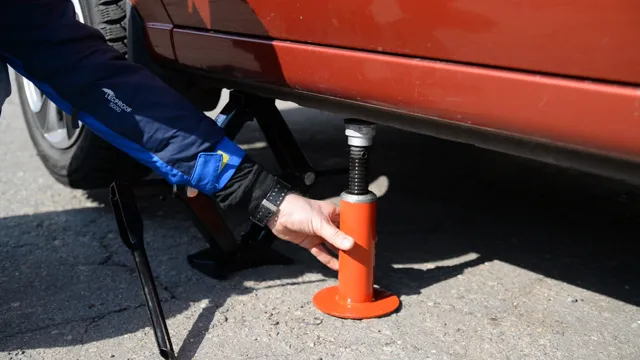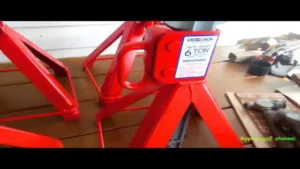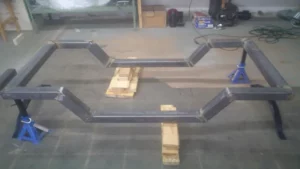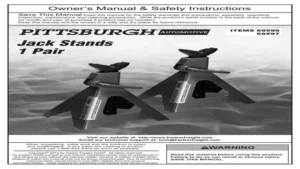Jack stands are an essential tool for any car enthusiast or mechanic. They provide a safe and stable platform for working on the underside of a vehicle, making maintenance tasks such as oil changes and suspension work much easier. However, many people may feel intimidated by the process of putting a car up on jack stands, especially if they haven’t done it before.
The truth is, putting a car up on jack stands is a relatively simple process that anyone can learn. With a few basic tools and some careful attention to detail, you can take your car off the ground in a matter of minutes. In this blog post, we’ll walk you through the steps involved in putting a car up on jack stands, giving you the confidence you need to tackle this important task.
So grab your tools and let’s get started!
Gather the Materials
Before anything else, if you’re wondering how to put a car up on jack stands, you’ll need the right tools. You’ll need a pair of high-quality jack stands, a hydraulic jack, and a lug wrench. Once you have all these materials, you’re almost good to go.
But keep in mind, not all jack stands and jacks are created equal. So make sure to use a quality and reliable pair of jack stands and hydraulic jack. Don’t skimp on these tools, or you might find yourself in a dangerous situation.
If you’re not sure which ones to get, ask someone who has experience with car repairs, or head to a reputable auto parts store. Remember, it’s always better to be safe than sorry.
Jack Stands
When it comes to using jack stands, it’s important to have all the necessary materials on hand before starting any work. To begin, you’ll need a pair of sturdy jack stands that are rated for the weight of your vehicle. Don’t skimp on this step, as using inadequate stands can lead to dangerous accidents.
You’ll also need a floor jack to lift your vehicle, a set of wheel chocks to prevent it from rolling, and a solid and level surface to work on. It’s a good idea to wear gloves and eye protection as well, in case of any mishaps. Gather all these materials together before starting your work, and make sure you have a plan in place for exactly what you need to do.
With the right preparation and safety precautions, using jack stands can be a safe and effective way to work on your vehicle.
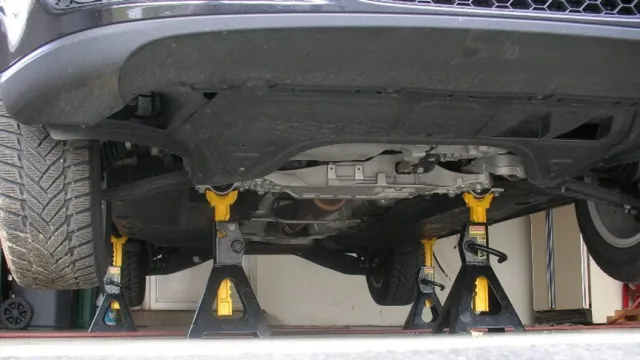
Floor Jack
Gathering the necessary materials before using a floor jack is crucial to ensuring a safe and successful lift. The first and most obvious material is the floor jack itself. It’s essential to make sure your floor jack is in good condition, with no visible damage or leaks.
Additionally, make sure the jack is the correct weight capacity for the vehicle you’re working on. Next, you’ll need a set of jack stands, which will provide the necessary support for the vehicle to stay lifted in the air. It’s important also to ensure that your jack stands are of appropriate weight capacity and quality.
Finally, you’ll need a lug wrench to remove the vehicle’s wheels, and a wheel chock to block the wheels still on the ground to prevent any unnecessary movement. With all the necessary materials gathered, you’ll be well on your way to a safe and successful lift with your floor jack.
Wheel Chocks
When it comes to safety precautions, using wheel chocks is a must-have for anyone working with heavy-duty vehicles. To ensure your vehicle stays stationary and doesn’t roll away, you’ll need to gather the appropriate materials to make your own wheel chocks. First, you’ll need wooden blocks that are at least 5 inches in width and 8 inches in length.
Next, you’ll need a saw to cut the blocks to the appropriate length, as well as sandpaper to smooth out any rough edges. Once your wooden blocks are cut and smoothed, you’ll need a sturdy rope or chain that’s at least 1/4-inch in thickness to run through each block and create a handle. Finally, you’ll need drill a pilot hole through each block and use screws to attach the rope handle securely.
With these simple materials, you can easily make your own wheel chocks to keep your vehicle in place and prevent any accidents. So, be sure to check your materials twice before starting your work and use an appropriate mask and gloves for your safety.
Preparation
Putting a car up on jack stands may seem like a daunting task at first, but with the right tools and preparation, it can be done safely and easily. Begin by selecting a flat and level surface to work on, away from any potential hazards like traffic. Then, gather your equipment, which includes a hydraulic jack, jack stands, and wheel chocks.
Once you’ve parked the car and secured the handbrake, use the hydraulic jack to lift the car off the ground, making sure to place it in the recommended lifting points recommended in the owner’s manual. Once the car is off the ground, slide the jack stands under the car and adjust their height until they fit snugly against the frame. Then, lower the car onto the jack stands and give it a gentle shake to ensure it’s secure.
Don’t forget to place wheel chocks behind the other wheels to prevent any movement. By following these steps and taking the time to prepare properly, you can safely put a car up on jack stands and get to work on maintenance and repairs.
Select a Solid Surface
When selecting a solid surface for your home or business, preparation is key. Before making any decisions, consider the purpose of the surface and the environment it will be in. For example, if the surface will be exposed to high temperatures or moisture, choose a material that can withstand those conditions.
Additionally, think about the style and aesthetic you want to achieve. Do you prefer a natural or modern look? How important is durability and maintenance? These factors can help narrow down the options and ensure you choose the right surface for your needs. Don’t rush through this step – taking the time to prepare will save you time and money in the long run.
Loosen the Lug Nuts
Before embarking on any car repair or maintenance task, one must always start with proper preparation. And when it comes to changing a tire, the first step is to loosen the lug nuts. These nuts keep the wheel attached to the car hub and can be quite stubborn to remove, especially if they have been overtightened or corroded.
To ensure that you can loosen them easily, you will need a lug wrench or a breaker bar and the right socket size. It’s also important to make sure your car is on a flat surface, the emergency brake is engaged, and the tire you will be changing isn’t still touching the ground. Remember, loosening the lug nuts should be the first thing you do, but don’t remove them completely until you’ve lifted the car using a jack and placed it on a sturdy jack stand.
By following these steps, you’ll avoid any unnecessary accidents and successfully change your tire in no time.
Place the Wheel Chocks
Before you start working on your vehicle, it’s essential to prepare your workspace. One crucial step is to place the wheel chocks in the right position. Wheel chocks are small wedges that prevent your vehicle from moving while you work on it, even if it’s on an inclined surface.
They help ensure your safety by keeping your car in place and preventing it from rolling out of position. To use them correctly, place them firmly behind the wheels on the opposite side of where you’ll be working. Make sure they’re in a flat-fitting position that matches the tire’s contour.
This way, the wheel chocks will hold the car firmly in place, and you can perform repairs without worrying about any accidental movement. Remember to remove the wheel chocks before you attempt to drive away. By taking this simple yet effective safety measure, you can help ensure a successful vehicle repair project.
Lifting the Vehicle
If you’re planning on working on your car, it’s important to know how to put a car up on jack stands. The process is fairly straightforward, but it’s important to take the necessary precautions to ensure your safety. First, find a level surface and put the parking brake on.
Use a floor jack to lift the car up from the jacking point under the vehicle. Jack stands should then be positioned near the car’s jacking points and gradually lowered onto the stands. Make sure the car is secure on the jack stands before working underneath it.
It’s important to never put any part of your body underneath a car that is only supported by a jack. Follow these simple steps to lift your vehicle safely and securely for maintenance or repairs.
Position the Floor Jack
When it comes to lifting your vehicle with a floor jack, proper positioning is key. Before beginning, ensure that the ground beneath the jack is level and stable. Place the jack in the appropriate spot under the vehicle as specified in your owner’s manual.
This position is typically near the wheels or suspension and may be indicated by a notch or crease in the vehicle’s frame. Check that the jack is properly centered and aligned before cranking the handle to raise the vehicle. Remember to never lift a vehicle from anywhere other than the recommended lifting points to avoid damaging the vehicle or putting yourself in danger.
By taking the time to properly position the floor jack, you can lift your vehicle with confidence and safety. So, go ahead and lift your vehicle for maintenance or repairs without any hassle.
Lift the Vehicle
“Jack up the Car” If you’re going to get underneath your car, whether it’s to change the oil or tackle a bigger mechanical issue, the first step is always to lift it up safely. Jacking up a car can be a bit intimidating if you’ve never done it before, but with the right tools and knowledge, it’s a straightforward process. First and foremost, you need to make sure you have a jack that is appropriate for your vehicle’s weight and model.
If you’re not sure, consult your car’s manual or do some research online. Once you have the right jack, find a flat surface to park on and put your car in park with the emergency brake engaged. Locate the jack points under your car and position the jack under one of them, making sure it’s lined up correctly before you start pumping.
As you pump the jack, keep an eye on your car to make sure it’s lifting evenly and not leaning to one side. Once you’re satisfied with the height, it’s time to put jack stands under the car to hold it up securely. Remember to never rely solely on a jack to hold up your car while you work on it – always use jack stands as a backup.
Place the Jack Stands Under the Vehicle
When it comes to lifting a vehicle, safety should be a top priority, and that’s where jack stands come into play. These sturdy supports ensure that the car remains stable and doesn’t fall while you’re working on it. To begin, you’ll want to locate the recommended jacking points in your vehicle’s owner’s manual.
Place the jack under the car and slowly lift it up to the appropriate height. Once it’s raised to the correct level, carefully slide the jack stands underneath the car in the recommended lifting points. Double-check the stands’ stability, making sure they are secure and level, before proceeding with your work.
Remember that your safety depends on your judgement, so take your time and be cautious. With the right equipment and a careful approach, you can safely lift and work on your vehicle, knowing that the jack stands will keep you secure.
Lowering the Vehicle
When it comes to working on your vehicle, it’s important to know how to safely put it up on jack stands. Lowering the vehicle can give you better access to the undercarriage or wheels, but it’s crucial to do it correctly to prevent any accidents. First, park the car on a flat surface and engage the emergency brake.
Then, identify the proper jack points on your car, which are often indicated in the owner’s manual. Use a quality jack to lift the vehicle and place the jack stands securely under the designated areas. Slowly lower the vehicle onto the stands until it rests evenly.
Test the stability of the vehicle before proceeding with any work. Remember to never place yourself under the car while it is on the jack stands and always use caution when working with heavy machinery. By following these steps, you can safely lower your vehicle and get to work on repairs or maintenance.
Carefully Lower the Vehicle onto the Jack Stands
Lowering the vehicle onto the jack stands is a crucial step that requires attention to detail. Start by positioning the jack stands strategically under the car’s chassis where it can support its weight and provide stability. Ensure that you have successfully raised the vehicle, and the jack stands are sturdy enough to handle it.
Use caution while lowering the vehicle to avoid any potential accidents. Gently and slowly lower the vehicle onto the jack stands to ensure it lines up properly and doesn’t shift during the process. Always take the necessary precautions and double-check everything before lowering the vehicle to avoid any accidents or injuries.
Remember, safety should always be a top priority when working on your car.
Remove the Floor Jack
After successfully changing the flat tire or completing the necessary maintenance, it is time to remove the floor jack and lower your vehicle. This step is crucial to ensure your safety and prevent any damages to your vehicle. First, double-check that all lug nuts are tightened and the tools used are stored properly.
Then, locate the jack release valve and slowly turn it counterclockwise to lower the vehicle. Make sure to monitor the car’s descent and avoid releasing the valve too quickly to prevent sudden drops. Once the car is fully on the ground, remove the jack from underneath and store it in a secure location.
Remember to always practice caution and safety when using a floor jack to prevent accidents or injuries.
Tighten the Lug Nuts
After tightening the lug nuts, it’s time to lower your vehicle. This step is an essential part of the process because it ensures that all the wheels make solid contact with the ground. You’ll need to use the jack stand to lower your car slowly.
If you don’t have a jack stand, you can slowly release the jack and let your car down. However, be very careful when doing so because your vehicle is heavy, and it could quickly crush you or cause serious damage. Remember, safety should always be your utmost concern when working with your vehicle.
Additionally, don’t forget to recheck your lug nuts once you’ve lowered your car. Are they still tight? Double-check to ensure nothing has come loose. Taking these necessary steps will ensure that your vehicle is safe to drive on the road.
Final Tips and Warnings
When putting a car up on jack stands, safety should be your top priority. Make sure to choose a flat surface and set the parking brake before lifting the car. Also, be cautious of the weight capacity of the jack stands you are using.
It’s always recommended to use a higher capacity than the weight of the car to ensure stability. Similarly, avoid placing the stands too far apart, as this can cause the car to wobble and potentially fall. Lastly, be sure to follow the manufacturer’s instructions on the use of the jack stands, and never attempt to crawl under the car while it is supported by them.
By taking these precautions and using your jack stands properly, you can safely raise and support your vehicle for whatever maintenance is necessary.
Double-Check the Stability of the Vehicle
When it comes to ensuring your safety on the road, double-checking the stability of your vehicle is crucial. This means making sure your car is properly aligned and balanced, and that your tires are inflated to the appropriate pressure. Uneven or low tire pressure can make it difficult to steer and control your car, especially in challenging driving conditions.
Additionally, make sure your suspension and shocks are in working order, as any signs of wear or damage can significantly compromise your car’s stability. Regular maintenance and inspections can help you maintain your car’s stability and avoid unexpected breakdowns. Remember, being aware of your car’s stability not only can prevent accidents but also increase your overall comfort and enjoyment while driving.
Never Work Under a Vehicle that is Only Supported by a Jack
When working on a vehicle, it’s vital to ensure that it’s securely and stably supported throughout the process. One common mistake is to rely solely on a jack to hold up a car. Never work under a vehicle that is only supported by a jack, as this is extremely dangerous and could result in a serious injury or even death.
While jacks are useful for lifting up a car for maintenance, they were not designed for prolonged use and can easily give way. Instead, always use jack stands to provide additional support for the vehicle. When selecting jack stands, make sure they have enough weight capacity to handle your car and are adjusted to the appropriate height.
Remember, safety should always come first when working on a car.
Lower the Vehicle Slowly and Carefully
Lowering your vehicle may seem like a daunting task, but with the right preparation and careful approach, you can do it safely and smoothly. Before you start, make sure you have all the necessary tools and equipment, and that you understand the process thoroughly. Once you’ve completed the installation of your lowering kit, it’s time to lower the vehicle.
This should be done slowly and steadily, ensuring that the vehicle remains balanced and stable throughout. Gradually bring the vehicle down, checking to ensure that all components are aligned correctly and functioning properly. Keep an eye out for any signs of wear or damage, and if you notice anything out of the ordinary, stop immediately and seek professional assistance.
Remember to take it slow, and prioritize safety above all else. With the right approach, lowering your vehicle can be a rewarding and satisfying process.
Store Jack Stands Properly and Check Them Regularly
When it comes to storing jack stands, it’s essential to do so properly to ensure they’re in good condition when you need them. Firstly, make sure to clean them after each use and store them in a dry and clean area. Don’t leave them outside or exposed to the elements as this can cause rust and wear on the stand.
Additionally, be sure to check the weight rating regularly and inspect for any cracks or damage. Using a faulty or worn-out jack stand can result in serious injury or even death. Lastly, always use them on a flat and stable surface, as using them on an uneven surface can cause them to slip or tip over.
Remember, proper storage and maintenance of your jack stands can prolong their lifespan and ultimately keep you safe while working on your vehicle.
Conclusion
And that, my friends, is how you lift your ride up like a boss. So, next time you’re looking to change out your oil or get under the hood for some tinkering, remember to follow these steps carefully and stay safe in the process. Because nothing says car enthusiast quite like a slick set of jack stands and a can-do attitude.
“
FAQs
What is the proper way to position the car on jack stands?
The car should be on a level surface and the jack stands should be placed on a solid and flat surface underneath the car’s designated jack points.
How do I safely lift the car onto the jack stands?
First, use the car jack to lift the car up to the desired height. Then, place the jack stands underneath the car’s designated jack points and lower the car onto the stands.
Can I use regular car jacks instead of jack stands?
It is not recommended to use regular car jacks to support the weight of the vehicle for an extended period of time. Jack stands are designed specifically for this purpose and provide a much safer option.
How many jack stands do I need to use?
It is recommended to use at least two jack stands to provide even weight distribution and to prevent the car from tipping over.
What is the weight capacity of the jack stands I should use?
The weight capacity of the jack stands should be equal to or greater than the weight of your vehicle. Check the manufacturer’s instructions for specific weight limits.
How do I lower the car from the jack stands safely?
Slowly and carefully raise the car slightly with the car jack while removing the jack stands one at a time. Once the jack stands are removed, lower the car back down to the ground.
What are some common mistakes to avoid when using jack stands?
Some common mistakes to avoid include using the wrong type of jack stands, positioning the car on an uneven surface, and not properly securing the jack stands under the car’s designated jack points. Always refer to the manufacturer’s instructions for proper use and safety precautions.
